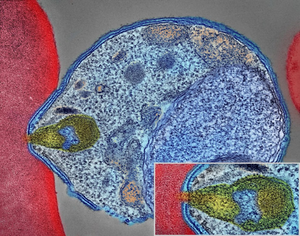Difference between revisions of "Malaria"
| Line 30: | Line 30: | ||
:[https://www.amazon.co.uk/gp/product/1471851338/ref=as_li_tl?ie=UTF8&camp=1634&creative=6738&creativeASIN=1471851338&linkCode=as2&tag=nrjc-21&linkId=425855d5890466e47189e1c21b67a1ea ''Malaria, pages 84-5, GCSE Biology, Hodder, AQA ''] | :[https://www.amazon.co.uk/gp/product/1471851338/ref=as_li_tl?ie=UTF8&camp=1634&creative=6738&creativeASIN=1471851338&linkCode=as2&tag=nrjc-21&linkId=425855d5890466e47189e1c21b67a1ea ''Malaria, pages 84-5, GCSE Biology, Hodder, AQA ''] | ||
:[https://www.amazon.co.uk/gp/product/0198359373/ref=as_li_tl?ie=UTF8&camp=1634&creative=6738&creativeASIN=0198359373&linkCode=as2&tag=nrjc-21&linkId=952a73bbb09d222ecc4b50d200679849 ''Malaria, pages 88-89, 201, GCSE Biology; Third Edition, Oxford University Press, AQA ''] | :[https://www.amazon.co.uk/gp/product/0198359373/ref=as_li_tl?ie=UTF8&camp=1634&creative=6738&creativeASIN=0198359373&linkCode=as2&tag=nrjc-21&linkId=952a73bbb09d222ecc4b50d200679849 ''Malaria, pages 88-89, 201, GCSE Biology; Third Edition, Oxford University Press, AQA ''] | ||
| + | |||
| + | ====Edexcel==== | ||
| + | |||
| + | :[https://www.amazon.co.uk/gp/product/1292120207/ref=as_li_tl?ie=UTF8&camp=1634&creative=6738&creativeASIN=1292120207&linkCode=as2&tag=nrjc-21&linkId=22455ff53961978667722edaa64c0be5 ''Malaria, page 102, GCSE Biology, Pearson, Edexcel ''] | ||
| + | :[https://www.amazon.co.uk/gp/product/1782948120/ref=as_li_tl?ie=UTF8&camp=1634&creative=6738&creativeASIN=1782948120&linkCode=as2&tag=nrjc-21&linkId=dedef775c6a43dbb0a609441525adac0 ''Malaria, page 156, GCSE Biology, CGP, Edexcel ''] | ||
| + | :[https://www.amazon.co.uk/gp/product/1782945741/ref=as_li_tl?ie=UTF8&camp=1634&creative=6738&creativeASIN=1782945741&linkCode=as2&tag=nrjc-21&linkId=30da4f2178da182547b62a7329d13b57 ''Malaria, page 39, GCSE Combined Science; The Revision Guide, CGP, Edexcel ''] | ||
| + | :[https://www.amazon.co.uk/gp/product/1782946748/ref=as_li_tl?ie=UTF8&camp=1634&creative=6738&creativeASIN=1782946748&linkCode=as2&tag=nrjc-21&linkId=a4f0348fc37d0ba1bb52d27f8679581f ''Malaria, page 55, GCSE Biology; The Revision Guide, CGP, Edexcel ''] | ||
| + | :[https://www.amazon.co.uk/gp/product/1292120193/ref=as_li_tl?ie=UTF8&camp=1634&creative=6738&creativeASIN=1292120193&linkCode=as2&tag=nrjc-21&linkId=572df39392fb4200db8391d98ae6314e ''Malaria, page 74, GCSE Combined Science, Pearson Edexcel ''] | ||
Revision as of 16:32, 22 November 2019
Contents
Key Stage 4
Meaning
Malaria is a disease caused by pathogenic protists called Plasmodia.
About Malaria
- The malaria protist lives in the blood of humans and reproduces in the liver.
- Malaria can lay dormant, not causing any symptoms, for months at a time.
- Malaria causes fevers, liver damage and damage to the red blood cells.
- Malaria is transmitted by the mosquito which is referred to as a vector for the pathogen.
- Malaria is not easily treated and most people will have malaria for their entire lives.
- People with the genetic disorder; 'Sickle Cell Anemia' have sickle shaped red blood cells which helps prevent malaria infections.
The transmission of malaria can be prevented or reduced by:
- Killing mosquitos with insecticide.
- Destroying the habitat of the mosquito. (Areas of stagnant water.)
- Taking antimalarial drugs.
- Using mosquito nets that can be placed over beds.
Beyond the Curriculum
References
AQA
- Malaria, page 127, GCSE Combined Science Trilogy; Biology, CGP, AQA
- Malaria, page 133, GCSE Biology, CGP, AQA
- Malaria, page 45, GCSE Combined Science; The Revision Guide, CGP, AQA
- Malaria, page 47, GCSE Biology; The Revision Guide, CGP, AQA
- Malaria, page 47, GCSE Biology; The Revision Guide, CGP, AQA
- Malaria, page 84, GCSE Combined Science Trilogy 1, Hodder, AQA
- Malaria, pages 84-5, GCSE Biology, Hodder, AQA
- Malaria, pages 88-89, 201, GCSE Biology; Third Edition, Oxford University Press, AQA
